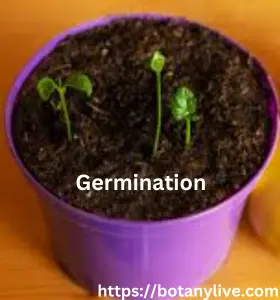Lemon Tree Growth Stages – Guide to Pant and Care
Before planting them and getting juicy lemon fruits, you need to know the various stages of tree growth, from germination to harvesting. These trees grow faster than the others, taking 2 to 2.5 years to fruit successfully. This growth cycle consists of 7 different stages. Let’s explore these stages and try to understand this growth chart with pictures.
Lemon Tree Growth Stages – 7 Phases
Lemon trees belong to the citrus genus and are known scientifically as Citrus limon. These are evergreen trees. They typically start their journey from seeds, which germinate under optimal water, acidity, temperature, and soil conditions. All these conditions are marked in the growth chart of lemon growth phases.
1. Germination stage
The first phase in the growth timeline of a lemon tree is germination from the seed. It has only a sexual type of reproduction with seeds. Seed, sown in the soil (land or pot), absorbs water and swells, eventually sprouting a tiny root known as a radical into the soil, followed by a plumule rising.
This germination process may take 5-7 days. Lemon seeds prefer to grow in 70 and 85 degrees Fahrenheit (21-29 degrees Celsius) and well-drained acidic soil. They can germinate indoors as well. This marks the emergence of the seedling.

2. Seedling stage
After germination, the seedling is ready to face the outer environment. The seedling time lapses from 7 to 20 days. It soon develops into a young leafy seedling for photosynthesis. It keeps on adding new leaves and increasing the height of the stem.
This stage of lemon tree growth is quite crucial. Providing adequate moisture, warmth, and sunlight to support healthy growth is vital during this stage. If you are using a pot for establishment, you can shift it to a shady place.

3. Maturity and Vegetative Growth
As the lemon tree grows, it enters the maturity stage, the sapling stage. This growth stage of lemon is characterized by vigorous vegetative growth. The tree produces new leaves and branches, establishing a solid framework for future fruit production.
Proper pruning and nutrient management are essential for better blooming, fruiting, and bud formation as the tree is in active growth. Pruning can give a better shape to the tree and encourage optimal growth.

4. Flowering and Fruiting
This lemon tree growth stage marks the time for flowering, blooming, and fruiting. It is one of the most exciting stages of the lemon tree life cycle. The tree bursts into a spectacle of fragrant blossoms. The time of flowering is early spring (February / March). Lemon flowers are open and typically self-pollinating, meaning they can produce fruit without cross-pollination from other trees.
Once pollinated, the flowers give way to small green fruits, which gradually grow and mature over time. Moreover, this is the time of the active growth stage, and thus, it needs more frequent water.

5. Ripening and Harvesting
As the lemon fruits mature and ripen in four months or so. They undergo a gradual color change from green to yellow, indicating ripeness. They will appear shiny if well-hydrated and cared for during the earlier growth stages. The fruit could be round, oval, elliptical, or irregular.
Try to harvest well-ripe yellow fruits. Harvesting should be done carefully, avoiding damage to the fruits and branches. Lemons can be harvested at various stages of ripeness, depending on personal preference and culinary use. They were harvesting lemons when fully ripe for optimal flavor and juiciness.

6. Drying and Preservation
While fresh lemons are delightful, there are times when preserving them becomes necessary. Drying is a popular method of preserving lemons, which involves slicing the fruits thinly and dehydrating them until they become leathery. Dried lemon slices can be stored in airtight containers and used as flavoring agents in various dishes and beverages.
Try to harvest well-ripe yellow fruits. Harvesting should be done carefully, avoiding damage to the fruits and branches. Lemons can be harvested at various stages of ripeness, depending on personal preference and culinary use. They were harvesting lemons when fully ripe for optimal flavor and juiciness.

Lemon Tree Care Tips During Growth Stages
Taking care of lemon trees requires attention to detail and regular maintenance. Here are some essential tips for healthy lemon trees:
- Growing Conditions: Lemon trees thrive in warm climates with plenty of sunlight and well-drained soil. Ensure proper irrigation and fertilization to support robust growth.
- Pruning: Regular pruning helps maintain the shape and size of the lemon tree and promotes air circulation and sunlight penetration within the canopy.
- Soil pH: Lemon trees prefer slightly acidic soil with a pH range of 5.5 to 6.5. Test your soil regularly and amend it to maintain optimal pH levels.
- Pest and Disease Management: Check for common pests and diseases affecting lemon trees, such as citrus leaf miners and greening disease. Use organic pest control methods whenever possible to minimize chemical exposure.
- Nutrient Management: Ensure proper nutrient balance by applying a balanced fertilizer specifically formulated for citrus trees. Pay attention to signs of nutrient deficiencies and adjust fertilization accordingly.
FAQs
I’m Dr Qaiser Maqsood (PhD), a dedicated researcher and expert in Biological Sciences, Gardening, Bio-Diversity, Ecology, and Environmental Sciences. I’m much concerned about Environmental Pollution, Climate Change, Plantation, Gardening, and Global Warming. My passion is to explore innovative solutions in all these fields.
Be aware that we have ONLY ONE EARTH. Protect it!!






